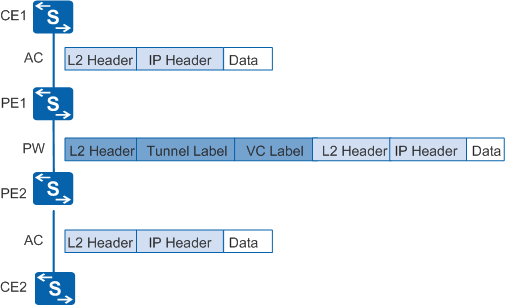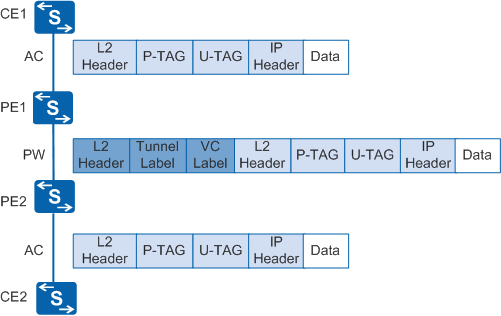Packet Encapsulation
Packet Encapsulation on ACs
Packet encapsulation on ACs depends on the user access mode, which can be either VLAN or Ethernet. The default user access mode is VLAN.
Packet Encapsulation Type |
Description |
|---|---|
VLAN |
The header of each Ethernet frame sent between CEs and PEs carries a VLAN tag, known as the provider-tag (P-Tag). This is a service delimiter identifying users on an ISP network. |
Ethernet |
Ethernet frame headers do not contain P-Tags. If the frame header contains a VLAN tag, it is an inner VLAN tag called the user-tag (U-Tag). A CE does not add the U-Tag to an Ethernet frame; instead, the tag is carried in a packet before the packet is sent to the CE. A U-Tag informs the CE to which VLAN the packet belongs, and is meaningless to PEs. |
Packet Encapsulation on PWs
The PW ID and PW encapsulation type together uniquely identify a PW. The PW IDs and PW encapsulation types configured on both end PEs of a PW must be the same. The packet encapsulation types on PWs can be raw or tagged. By default, packets are encapsulated in tagged mode.
Packet Encapsulation Type |
Description |
|---|---|
Raw |
Packets transmitted over a PW cannot carry P-Tags. If a PE receives a packet with the P-Tag from a CE, the PE strips the P-Tag and adds double labels (outer tunnel label and inner VC label) to the packet before forwarding it. If a PE receives a packet with no P-Tag from a CE, the PE directly adds double labels (outer tunnel label and inner VC label) to the packet before forwarding it. The PE determines whether to add the P-Tag to a packet, depending on the configuration, before sending it to a CE. The PE is not allowed to rewrite or remove an existing U-Tag. |
Tagged |
Packets transmitted over a PW must carry P-Tags. If a PE receives a packet with the P-Tag from a CE, the PE directly adds double labels (outer tunnel label and inner VC label) to the packet before forwarding it. If a PE receives a packet with no P-Tag from a CE, the PE adds a null P-Tag and double labels (outer tunnel label and inner VC label) to the packet before forwarding it. The PE determines whether to rewrite, remove, or preserve the P-Tag of a packet, depending on the configuration, before forwarding it to a CE. |
VPLS Packets and Encapsulation Modes
Encapsulation modes of packets transmitted over ACs and PWs can be used together. The following uses Ethernet + raw encapsulation (without U-Tag) and VLAN + tagged encapsulation (with U-Tag) as examples to describe the packet exchange process.
Ethernet + raw encapsulation (without U-Tag)
In Figure 1, ACs use Ethernet encapsulation and PWs use raw encapsulation. Packets transmitted from CEs to PEs do not carry U-Tags.
The packet exchange process is as follows:
CE1 sends a Layer 2 packet without a U-Tag or P-Tag to PE1.
PE1 searches the corresponding VSI for a forwarding entry and selects a tunnel and a PW to forward the packet based on the found forwarding entry.
PE2 receives the packet from PE1 and decapsulates the packet by removing the Layer 2 encapsulation header added by PE1 and the inner VC label of the packet (the outer tunnel label has been popped out at the penultimate hop).
PE2 sends the original Layer 2 packet to CE2.
The process of sending a packet from CE2 to CE1 works similarly.
VLAN + tagged encapsulation (with U-Tag)
In Figure 2, ACs use VLAN encapsulation and PWs use tagged encapsulation. Packets transmitted from CEs to PEs carry U-Tags and P-Tags.
The packet exchange process is as follows:
CE1 sends a packet encapsulated at Layer 2 and carrying both a U-Tag and a P-Tag to PE1.
PE1 receives the packet but does not process either tag. PE1 retains the U-Tag because it treats the U-tag as service data.
- PE1 retains the P-Tag because a packet sent to a PW with the tagged packet encapsulation mode must carry a P-Tag.
- PE1 searches the corresponding VSI for a forwarding entry and selects a tunnel and a PW to forward the packet based on the forwarding entry found.
- PE1 adds double labels (outer tunnel label and inner VC label) to the packet based on the selected tunnel and PW, performs Layer 2 encapsulation, and forwards the packet to PE2.
PE2 receives the packet from PE1 and decapsulates the packet by removing the Layer 2 encapsulation header added by PE1 and the inner VC label of the packet (the outer tunnel label has been popped out at the penultimate hop).
PE2 forwards the original Layer 2 packet to CE2. The packet carries the U-Tag and P-Tag.
The process of sending a packet from CE2 to CE1 works similarly.
Processing of Tags Carried in Packets
The system processes packets according to their AC interface and PW encapsulation types.
Two PW encapsulation modes can be used: Ethernet encapsulation (raw mode) and VLAN encapsulation (tagged mode).

- The link type of the AC interface is trunk, and the VLAN tag of packets is the same as the PVID of the interface.
- The link type of the AC interface is hybrid, and the VLAN tag of packets is the same as the untagged VLAN ID or PVID of the interface.
PW Encapsulation Type |
Processing Logic |
|---|---|
VLAN encapsulation |
Do not process the P-Tag carried in a packet. |
Ethernet encapsulation |
If a P-Tag is carried in a packet, delete the P-Tag from the packet. If no P-Tag is carried in a packet, do not process the packet. |
AC Interface Type |
Processing Logic |
|---|---|
GE, XGE, 25GE, MultiGE, 40GE, 100GE, or Eth-Trunk interface |
Do not process the packet. |
VLANIF interfaces |
If a P-Tag is carried in a packet, rewrite the P-Tag. If no P-Tag is carried in a packet, add a P-Tag to the packet. |
VLAN stacking sub-interface |
If a P-Tag is carried in a packet, delete the P-Tag from the packet. If no P-Tag is carried in a packet, do not process the packet. |
VLAN mapping sub-interface |
If a P-Tag is carried in a packet, rewrite the P-Tag. If no P-Tag is carried in a packet, add a P-Tag to the packet. NOTE:
The added or replaced tag is the VLAN tag on the interface where VLAN mapping is not performed. |
Dot1q sub-interface |
Do not process the packet. |
QinQ sub-interface |
Do not process the packet. |

